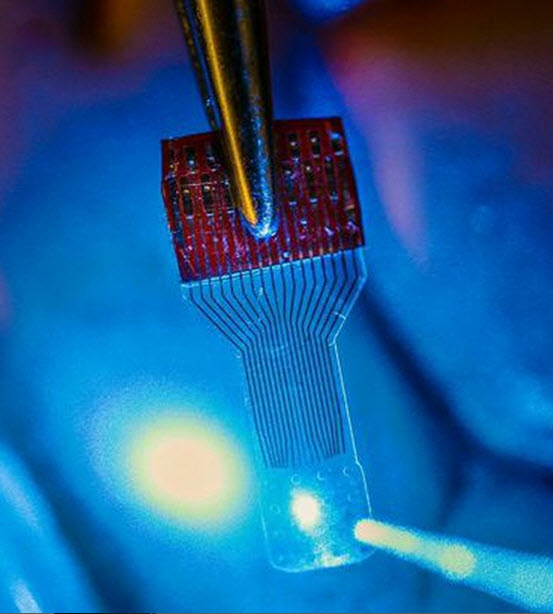Transparent graphene-based sensors open new window into the brain
October 21, 2014

A blue light shines through a clear implantable medical sensor onto a brain model. See-through sensors developed by UW-Madison engineers, should help neural researchers better view brain activity. (Photo credit: Justin Williams research group)
University of Wisconsin-Madison engineers have developing invisible implantable medical sensor microarrays to allow for seeing brain tissue hidden by implants.
The researchers chose graphene because it allows the electronic circuit elements to be transparent across a large spectrum — from ultraviolet to deep infrared. “It is soft and flexible, and a good tradeoff between transparency, strength and conductivity,” says Zhenqiang (Jack) Ma, a professor of electrical and computer engineering at UW-Madison.
The transparent sensors could be a boon to neuromodulation therapies, which physicians increasingly are using to control symptoms, restore function, and relieve pain in patients with diseases or disorders such as hypertension, epilepsy, Parkinson’s disease, or others, says Kip Ludwig, a program director for the National Institutes of Health neural engineering research efforts.
Currently, he says, researchers are limited in their ability to directly observe how the body generates electrical signals, as well as how it reacts to externally generated electrical signals. “Clear electrodes in combination with recent technological advances in optogenetics and optical voltage probes will enable researchers to isolate those biological mechanisms. This fundamental knowledge could be catalytic in dramatically improving existing neuromodulation therapies and identifying new therapies.”
The research is profiled in the Oct. 20 issue of the online journal Nature Communications (open access), with funding from the Reliable Neural-Interface Technology program at the Defense Advanced Research Projects Agency, the National Institutes of Health, and the U.S. Office of Naval Research.
Abstract of Graphene-based carbon-layered electrode array technology for neural imaging and optogenetic applications
Neural micro-electrode arrays that are transparent over a broad wavelength spectrum from ultraviolet to infrared could allow for simultaneous electrophysiology and optical imaging, as well as optogenetic modulation of the underlying brain tissue. The long-term biocompatibility and reliability of neural micro-electrodes also require their mechanical flexibility and compliance with soft tissues. Here we present a graphene-based, carbon-layered electrode array (CLEAR) device, which can be implanted on the brain surface in rodents for high-resolution neurophysiological recording. We characterize optical transparency of the device at >90% transmission over the ultraviolet to infrared spectrum and demonstrate its utility through optical interface experiments that use this broad spectrum transparency. These include optogenetic activation of focal cortical areas directly beneath electrodes, in vivo imaging of the cortical vasculature via fluorescence microscopy and 3D optical coherence tomography. This study demonstrates an array of interfacing abilities of the CLEAR device and its utility for neural applications.